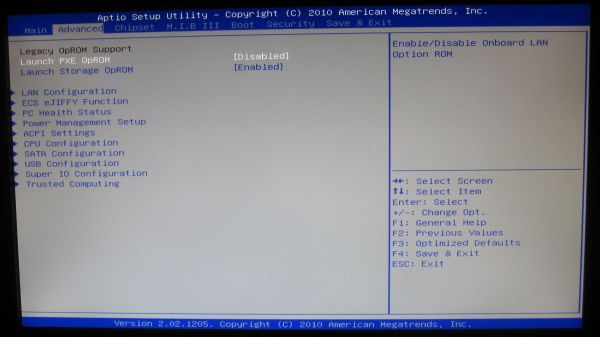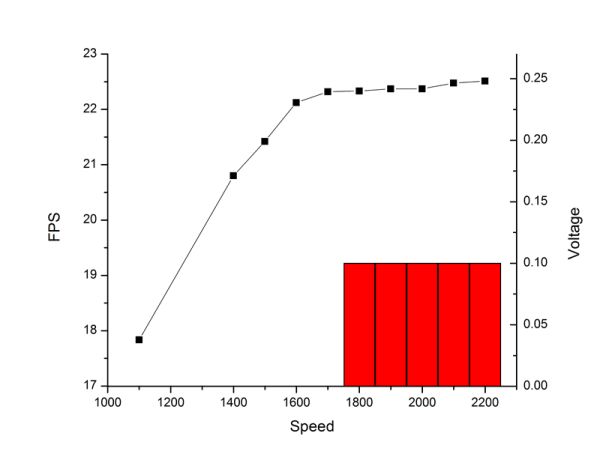H67 – A Triumvirate of Tantalizing Technology
by Ian Cutress on March 27, 2011 6:25 PM EST- Posted in
- Motherboards
- Sandy Bridge
- H67
BIOS
Out of the Sandy Bridge chipset UEFI/BIOSes I have seen so far, the ECS implementation, whilst functional, is not breaking any new ground. In actual fact, it can be a bit of a pig to use. It is not always obvious where options are for a start.
There is no main screen to see what you have got installed, what voltages are being applied, what temperature it is running at, what DIMMs you have installed, etc. The best is this screen shown above, which gives the processor, some voltages and total memory. There is another screen with similar information and the ‘system temperature’, which could either be the CPU, or the Chipset, or an average of the two.
The smart fan options give you Normal/Quiet/Silent/Manual, and all the options above (except CPU Fan Full Speed Offset) can be changed. There is no high performance option if you want/need the fan on full all the time however.
A lot of the BIOS options are embedded in the Advanced Menu, and in one of the subsequent sub-menus within. A lot of these sub-menus have a single option or two, meaning that there is constant flicking between them if you want to check every system setting. Not exactly the best way of organizing a BIOS in my opinion – and seasoned BIOS users are used to pressing F10 on almost all motherboards as the button for ‘Save and Exit’. ECS have confusingly set this to F4.
One positive option I like in the BIOS, which is not available in various UEFIs such as the ASRock, is the ability to perform a one-off boot selection from a different device, such as a bootable USB, without having to change the order of the boot devices both before and after what you have done.
Also, as I mentioned previously, there is an oddity with the RAM timings on the board. If your kit is 1333 MHz C9, then the board will run them at 1333 MHz C9. If your memory is faster than this, it will default to 1333 MHz 8-8-8-24. Also, these timings are unchangeable in the BIOS itself. While H67 boards will not go above 1333 MHz, usually the sub-timings are interchangeable at least.
Overclocking
Overclocking on the ECS board was difficult, confusing, and initially fruitless. The i5-2500K we used has an 850 MHz Intel HD 3000 Graphics core, with a Turbo Boost up to 1100 MHz. However, in the ECS BIOS options, there is very little to change.
If you can find the OC options by going through the MIB III -> Performance Tuning -> Chipset Configuration menus, there are three different options: Current, Ratio, and Voltage. The Ratio option is obviously the critical one here, but surprisingly it gives options between 17x and 60x but doesn’t tell you what value that multiplier is multiplied by – naturally, we assumed 100 MHz given the bus speed, but this isn’t the case here. After much testing thinking it was 100 MHz, ECS indirectly have told us that this is multiplied by 50 MHz to give the integrated graphics speed, which is inline with what we saw on the ASRock board.
Putting the multiplier at 28x gave 1400 MHz on the integrated GPU, which ran Metro2033 fine. All the way up to 34x (1700 MHz) also worked without increasing the voltage, and gave 22.32 FPS for Metro2033. At 36x (1800 MHz), the OS loaded fine, but then became unstable – upping the Graphics Voltage to 0.1V made this stable, but gave no difference in FPS from 1700 MHz. At 38x (1900 MHz), again the OS was fine, but still no FPS difference (22.37 FPS) at the same voltage. To double check nothing was wrong, I upped the Graphics Current from Normal to Max, at which point Metro2033 crashed on its first run. At 40x, 42x and 44x, the same thing happens – no FPS increase.
This behaviour is similar to the ASRock board, except rather than hitting a maximum and decreasing, the ECS board levels out:
For a ‘Black Series’ moniker on a board, the GPU overclock does well. Overclock results were:
- Metro2033: 22.33 FPS, up 26.2% from 17.7 FPS
- Dirt2: 32.2 FPS, up 18.95% from 27.07 FPS




















56 Comments
View All Comments
bupkus - Monday, March 28, 2011 - link
Agreed. The i3-2100 is a true budget cpu, imho. It should be matched with a true budget mobo-- namely the H61. I hope to see some more info on boards made with that chipset.Taft12 - Monday, March 28, 2011 - link
It's not accurate to call the i3-2100 a "true budget CPU" while we've got stuff like the Athlon II X2 and Pentium E5xxx on the market.cjs150 - Monday, March 28, 2011 - link
I am pleased you said this, because this is something I do not understand either, H67 looks to be a waste of timeASrock seems the best of this silly catagory. I have one of their boards in a file server, nice board, just works without fuss. Perfect for a server. May look at them for next build, instead of my usual ASUS fetish.
One thing though that really bugs me. Why on all the Micro-ATX boards out there do they insist on having the top PCI-E so close to the bottom end of the memory sockets. Have the MB manufacturers not noticed that high end memory is shipping with cooling fans? Several times I have found it impossible to fit a graphics card and the memory fan, virtually every time at the very least I have to ensure that there are no possible shorts by putting electricians tape around the bottom of the memory fan clup on. MB manufacturers it is not difficult, move the PCI-E slot down by 5mm or the memory sokets up by 5mm
bigboxes - Monday, March 28, 2011 - link
Not a bash, but fans on DDR3 ram is mostly frivolous waste. Heck, most ram today doesn't even need fancy heatspreaders because they run so cool. This is about the H67 chipset so I don't think many would waste time/money on buying high end memory that offers little in the terms of performance. Don't worry, Z68 is coming soon and you'll be able to buy your full ATX board that you can load up with the latest and greatest in parts to get that XTREME o/c. This chipset is not marketed for you.ArtShapiro - Monday, March 28, 2011 - link
I'd like to think that I (a decided non-gamer) am the target audience.I currently have a physically large (huge?) desktop system in a Chenboro 105 case. No way this monster can fit in the alcove in my computer desk, so it sits on the floor with the usual scads of cables coming from the desk. What a royal pain to move, clean, etc.
I suspect this summer I'll have an H67 system in a tiny (maybe Antec 300-150) case, little bigger than my tiny Asus TS mini Windows Home Server machine. With no graphic card, this thing should be efficient and dwarf the performance of the existing monster.
The H67 setup fits my needs to an alarming degree!
Art
Concillian - Tuesday, March 29, 2011 - link
What about this system cannot be handled by a significantly cheaper H61 motherboard? I missed that part of why H67 was perfect.
Taft12 - Tuesday, March 29, 2011 - link
He's not a gamer, but maybe he wants the SATA 6Gbit ports? 4 memory slots? USB 3.0?H61 boards are lacking, well, a lot if you're want anything beyond ultra-entry-level.
ArtShapiro - Wednesday, March 30, 2011 - link
Pure power. The cost is irrelevant (within reason); the increased processor of, say, the 2500/2500K will be a nice thing in processor-heavy applications and will probably ensure a longer relevant lifetime for the machine.I figure it's worth it to shell out a little more upfront for the H67.
Art
bobbyto34 - Monday, March 28, 2011 - link
Thanks a lot for testing DPC Latency. This can be a major issue for DAW's users.Spoelie - Monday, March 28, 2011 - link
I would concede that an integrated GPU is a very valuable tool for any computer user. It can be used to eliminate variables when troubleshooting a system, and to prevent downtime when the discrete GPU passes away. For this reason and this reason alone I personally don't buy a system without an integrated GPU anymore, even though I always have discrete GPUs. At least in 2 cases this has helped me tremendously.My personal preference is a cheap but good overclocking mATX board with (support for) iGPU & at least 1 eSATA port. Couldn't care less about SLI/XFire & RAID5, so the 785+SB710 board I now use was perfect, but without USB3 and SATA6 it's starting to show its age. One of the reasons I haven't switched to SNB is that Intel can't provide me that platform yet.
Here's to hoping for cheap mATX Z68 and cheap(er) K series CPUs.